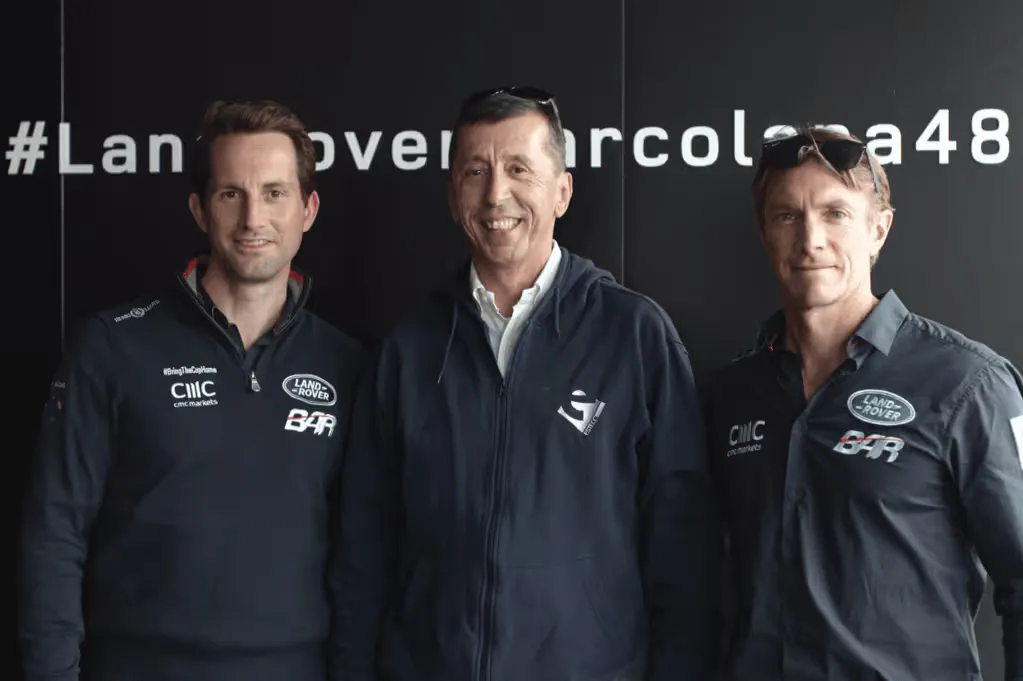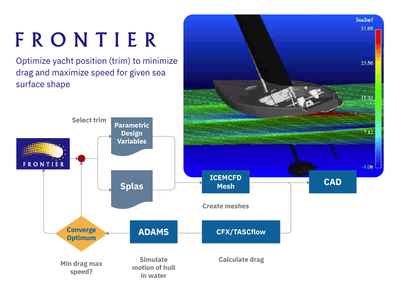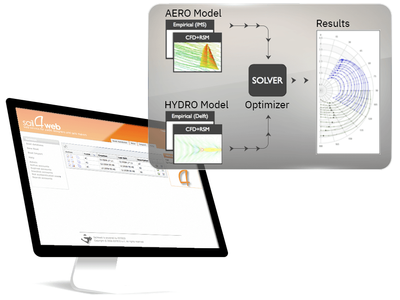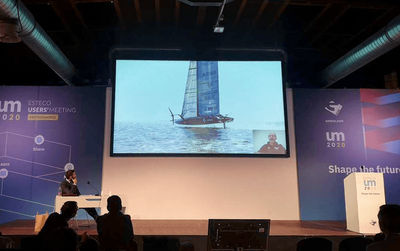25 years of ESTECO: Fostering innovation in sailing with Design Optimization
Written by Carlo Poloni
12 August 2024 · 10 min read

In a previous post, I mentioned that sailing yachts have always represented fruitful ground for multidisciplinary design optimization (MDO). Sailing is an important element of the local culture in our hometown of Trieste, Italy. The city, located on the Adriatic Sea, has a long history of sailing and maritime events like the Barcolana regatta - named by the Guinness World Records as the “Largest Sailing Race in the World” in 2019 with over 2689 registered yachts. The 48th edition of the Barcolana counted two very special guests - Sir Ben Ainslie and Matt Cornwell from America’s Cup Land Rover BAR team.
With the race set in Trieste, the home of ESTECO, it was the perfect opportunity to meet up with one of our technical partners. Touching base with our partners is always important as it really helps us focus on our goal of winning the America's Cup. We really appreciate the help ESTECO is giving us.

From left to right: Ben Ainslie, Enrico Nobile - ESTECO founder and scientific advisor and Matt Cornwell.
Given the critical role of MDO analysis in improving race yacht performance and our passion for sailing, it's no surprise that, from the outset, the challenges in this field have accompanied the development of ESTECO from the very beginning. As we celebrate 25 years of pushing the boundaries of numerical optimization, we're counting the days to the final phase of the 37th America's Cup. It's the perfect time to recount a quarter century of advancement in the sailing industry. Our simulation process automation and design optimization technology has driven sailing innovation, from our very first pioneering projects in the early 2000s to the latest Luna Rossa flying AC75s.
Pioneers in applying design optimization to sailing yacht applications
Since our inception, we’ve been harnessing numerical analysis and optimization to elevate the performance of racing yachts. Why? Partly because of the nature of the physical problems involved in marine applications. They’re highly non-linear and the many variables involved affect the performance of the system. Various components have to be taken into account: free-surface effects, lifting bodies, and laminar to turbulent transition. Towing tanks and wind tunnels have been used for decades and are still considered the most reliable tools. However, there are drawbacks. A boat operates at the interface between two fluids and it’s impossible to reproduce the same conditions of the full scale phenomenon on a scale model. And, the numerical analysis and optimization of a racing yacht is a complex task that requires the integration of computer aided design (CAD) systems, mesh generators, computational fluid dynamics (CFD) codes, as well as performance prediction tools.
In 1999, the very year of the foundation of ESTECO, Luka Onesti (now our CTO) and I were still working respectively at the University of Trieste (Italy) and Parallab in Bergen (Norway) when our efforts in this field began to bear fruit. We submitted a paper - “Hybridization of a multi-objective genetic algorithm, a neural network and a classical optimizer for a complex design problem in fluid dynamics” - to the Computer Methods in Applied Mechanics and Engineering magazine published a year later. Machine Learning (ML), CFD and Numerical Optimization were all merged to design a sailing yacht fin keel that provided the best compromise between high hydrodynamic lift and low hydrodynamic drag. We had the opportunity to run this pioneer modeFRONTIER project on one of the most powerful supercomputers existing at that time, which was located in Norway. And as the horizons of design optimization were expanding, so too were the applications of modeFRONTIER in the sailing field. The work was in fact part of a broader range of activities involving the use of our software modeFRONTIER for optimizing sailing yacht design components:
- Symmetric laminar airfoil for a sailing boat fin keel
- Fluid structure interaction for a composite wing
- Hull, keel and bulb simulation
- Web-based simulation of sails project

The use of Frontier (now modeFRONTIER) software for Trim Optimization
Veleria Vencato (now Eurosail sailmakers), located in Trieste, was one of the first businesses in the sailing industry we worked with in 2001. With the help of ESTECO Technology, they were able to enhance their sail design process by automating and streamlining structural and CFD analysis for mainsails, jibs, and spinnakers.
Sail4web: a web service for yacht designers and sail makers
In the first decade of the 2000s, the engineering knowledge we gained from our extensive research into yacht design led us to envision a software tool dedicated to yacht designers. As computer-aided engineering (CAE) technology advanced, the accuracy of CFD in analyzing the flow around hulls and sails improved dramatically. However, numerical analysis wasn’t widely adopted in a systematic way. The high cost of CFD simulations didn’t always justify the expense incurred relative to the value of the product being analyzed. Additionally, the complexity of the simulation process itself presented a significant barrier, as it required specialized knowledge and expertise to effectively conduct and interpret the results. We designed Sail4web to respond to these challenges and provide yacht designers and sail makers with a web application that allowed them to use numerical methods for fluid field prediction in an easy and reliable way. The tool also included a database browser, a project editor and a post-process environment.

Sail4web components: free surface flow simulation around hulls and appendages, aeroelastic analyses of the sail plan and a Velocity Prediction Program (VPP)
A bit ahead of its time in 2005? Yes, it was. After five years of development and many projects, we paused our work on the Sail4web prototype - but not the idea of helping designers create the boats of the future. The expertise we acquired and our growing connections within the sail design community marked the beginning of a series of high-level partnerships in this field.
Our journey as engineering simulation technology provider at the America’s Cup
Our ties with the America’s Cup go back to the early 2000s, a thriving period for the competition. Although it’s known as the oldest trophy in sports, it was only in the 1980s that the America’s Cup gained a real, public engagement from all over the globe. As the “wow” effect grew, sailing technology advanced dramatically, from monohull displacement sailing boats to multihulls and boats literally flying on foils. It was increasingly becoming more of an engineering challenge. With design specifications becoming more restrictive and time for physical testing shorter, design optimization technology has become crucial for design teams at the America’s Cup. The more sophisticated the software engineers have at their disposal, the quicker they find the best design solutions.
1. modeFRONTIER software champions in the America's Cup community
We’ve taken part in the design of boats for the Cup ever since the graduation of two of my ex-students: Matteo Ledri (now Luna Rossa Prada Pirelli, previously Land Rover BAR and Artemis) and Silvio Arrivabene (now Alinghi Red Bull Racing, previously American Magic and Mascalzone Latino).
Our roots in academia and geographical location in a coastal city with a long-standing maritime tradition were key to creating and maintaining a strong network of professional relationships stemming from the University of Trieste. Our interaction with the America’s Cup world started when Vasco Vascotto, skipper of Mascalzone Latino, a potential challenger for the 32nd Cup, attended Silvio's dissertation in 2002. Vasco later joined the Mascalzone Latino team who reached out to us for preliminary activities in the field of free surface flow, optimization and meteo-marine services for the 2007 Louis Vuitton Cup held in Valencia, Spain.
Later, other alumni like Michele Stroligo (previously Oracle Team USA and Luna Rossa Challenge), Andrea Zugna (now Luna Rossa Challenge) and Antonio Montagner (American Magic) contributed to the development of America’s Cup sailing yachts with their academic background in Naval Architecture and Marine Engineering, and Mechanical Engineering from University of Trieste. Champions of modeFRONTIER in the field of sailing design have graduated and worked in other universities and organizations beyond regional borders. Our technology has been used by many engineers across the globe to improve America's Cup sailing yacht design performance.
2. Catamaran rules and design optimization at Luna Rossa Challenge, Land Rover BAR and Groupama Team France
The 34th edition of the America’s Cup was a breakthrough event in the world of sailing where AC72 catamarans equipped with foils and wing sails replaced traditional monohulls. When the Luna Rossa Challenge Team started developing the concept for the catamarans in view of their campaign for the 35th America’s Cup, they adopted modeFRONTIER as their process integration and design optimization tool of choice to ensure an integrated design approach from the earliest stages of the AC62 catamaran design process.
The automatic process was developed using modeFRONTIER. This set-up enabled us to use up to 400 cores for each design, significantly reducing the computational time from 10 hours to about 40 minutes.

Despite the Luna Rossa Challenge team withdrawing from the competition that year, we played our part in the 35th edition of the America’s Cup as technical supplier for both Land Rover BAR and Groupama Team France. In 2016, representatives of both teams joined us in Trieste for the modeFRONTIER International Users' Meeting to talk about how they used our software to speed up the design process of the foiling catamarans. In this video, Matteo Ledri, Simulation Team Leader at Land Rover BAR, explained why optimization is crucial to the team’s success.
Groupama's presentation focused on the CFD optimization of 2D sections related to hydrofoil performance, emphasizing how an engineering software tool like modeFRONTIER is a game changer in the battle for challenger selection.
modeFRONTIER has the advantage of a particularly intuitive user interface, good graphics management, simultaneous control of several processes and the availability of a support service.

3. Luna Rossa Prada Pirelli and American Magic: optimizing monohulls for the 36th America's Cup
It was surprising to see that the class rules for the 36th America's Cup completely changed again with a new boat concept: a monohull racing boat that doesn’t sacrifice the concept of flying boats. Two t-shaped side foils guarantee that the boat flies above the water. This meant that designers could no longer rely on previous experience, requiring them to develop a new boat from scratch. This is most likely why two of the competing teams, American Magic and Luna Rossa Prada Pirelli chose us as official technology supplier. We hosted an “optimization technology” match between the designers from the two teams on the stage of the ESTECO International Users’ Meeting 2020. American Magic chose modeFRONTIER to automate and execute the entire simulation process of geometry definition, force computation and boat speed estimation for the foil and sail design.
Our partnership with ESTECO brings great results. Working side-by-side with ESTECO engineers enables us to pool our respective expertise to get the most out of modeFRONTIER.

Martin Fischer, co-design coordinator of the Luna Rossa Prada Pirelli team, described how modeFRONTIER became an essential part of the team’s development efforts. In this interview, he explains how our software helped them in the preliminary design because these boats were completely new. Without it, they never would have found the hull shape they eventually deployed.
4. 37th America’s Cup: third consecutive race with Luna Rossa Prada Pirelli as official technology supplier
That brings us to the here and now. We're looking forward to the upcoming Louis Vuitton 37th America's Cup in Barcelona and proud to have been part of the development of the Luna Rossa Prada Pirelli yacht for three editions in a row. Our collaboration has been ongoing since the introduction of the fascinating AC75 flying hulls. With the help of ESTECO simulation process automation and design optimization technology, the design team has tested solutions and materials for their sailing yacht, built and developed in-house at the Cagliari base on Sardinia’s southern coast. Luckily, two CFD specialists from their design team attended our 2024 ESTECO International Users’ Meeting. Their presence added an extra element of excitement and anticipation for the upcoming Louis Vuitton America's Cup, which takes place in August - October 2024.
modeFRONTIER has become an indispensable tool in developing the new AC75 class boat, providing the design team with the necessary optimization techniques to excel in various fields such as hull and foil design.

modeFRONTIER for student-led sailing challenges: the experience of Audace and PoliTO Sailing Team
Over the course of our 25-year history, we have equipped educators with modeFRONTIER to teach students how to approach and solve multidisciplinary engineering problems, including marine applications. I would like to mention two university teams who leveraged our technology to design and optimize hull shapes of sailing prototypes.
The Audace Sailing Team from the University of Trieste used modeFRONTIER to shift from the traditional "design spiral" method to a multicriteria decision making approach to design a foiling boat. They were able to gain a complete view of the design space and understand the importance of the different variables of their foiling boat in a very short amount of time. In just 8 months, they designed, built, and tested the boat at Garda lake, winning the Foiling SuMoth Challenge in 2023.
The PoliTO (Polytechnic University of Turin) Sailing Team designs, builds and sails Skiff and Moth prototypes. For faster take-off and quicker boat speed, they used modeFRONTIER to optimize the shape of a Moth class hull using high-fidelity Response Surface Models (RSM) trained on CFD simulations
Both the teams recently presented their experiences at our International Users’ Meeting in June, and took part in the 2024 ESTECO Academy Video Contest. Having them on the same stage along with the engineers from Luna Rossa Prada Pirelli Team showcased our presence in the marine and sailing field, with applications spanning from education to elite sporting events. Our journey began 25 years ago as an academic spin-off, and by continuously fostering the vital connection between research and real-world applications, we've driven innovation that not only propels competitive sailing but also advances scientific understanding and industry standards and trains the next generation of engineering professionals.
25 years in the race for innovation
While I was doing research for this post, I was struck by a fascinating coincidence: the very first hull of Luna Rossa, labeled ITA 45, was launched in May 1999, just a few weeks after Luka, Enrico, and I founded ESTECO. It was a thrill to see that we share a 25-year journey characterized by a relentless pursuit of innovation and perfection.
Designing a sailing yacht is an inherently multidisciplinary endeavor, and creating a competitive yacht for the America’s Cup elevates this to an immense technical and human challenge. It is only through collaboration that such feats can be achieved. This is why we’re exceptionally proud to be on board once again, supporting Luna Rossa Prada Pirelli in their quest for victory. Our shared history and dedication to pushing the boundaries of what's possible underscore our commitment to excellence in the world of sailing.
Discover how Luna Rossa Prada Pirelli team can predict design performance for sailing yachts thanks to ESTECO modeFRONTIER simulation process automation.
Luna Rossa Prada Pirelli: predict design performance with numerical optimization
Discover how Luna Rossa Prada Pirelli team can predict design performance for sailing yachts thanks to ESTECO modeFRONTIER simulation process automation.
Luna Rossa Prada Pirelli: predict design performance with numerical optimization
Discover how Luna Rossa Prada Pirelli team can predict design performance for sailing yachts thanks to ESTECO modeFRONTIER simulation process automation.


